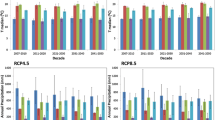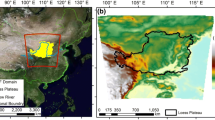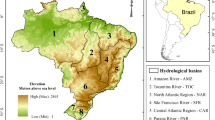Abstract
The Weather Research and Forecasting (WRF) model was applied as a downscaling tool over an orographically complex terrain along the Eastern Mediterranean. It was forced with the National Centers for Environment Prediction (NCEP) Final Analysis (FNL) (resolution 1°) for the years 2003 (a cold and wet year) and 2010 (a hot and dry year) and nested at sequential horizontal resolutions of 9 and 3 km. This study focuses on the assessment of simulated temperature and precipitation against data from an observational network over the study area. The observations comprise rain gauges and temperature stations with records of both daily average and/or maximum and minimum temperatures. The yearly precipitation validation shows that the WRF simulation has good agreement with the observed data, with a percentage bias of 3.80% in 2010. The errors in various extreme indices (such as minimum and maximum temperatures, number of hot or frost days, and rainfall intensity) were reduced by the downscaling, marking a large improvement over FNL analysis data in the description of temperature variability and extremes. These improvements support the benefits of dynamic downscaling over complex terrain, which can reduce the errors associated with mesoscales that are not resolved by the coarser driving model, and establish the skill of WRF for such downscaling.












Similar content being viewed by others
References
Abdul-Rahman S, Saoud IP, Owaied MK, Holail H, Farajalla N, Haidar M, Ghanawi J (2011) Improving water use efficiency in semi-arid regions through integrated aquaculture/agriculture. J Appl Aquac 23(3):212–230. https://doi.org/10.1080/10454438.2011.600629
Andrys J, Lyons TL, Kala J (2015) Multidecadal evaluation of WRF downscaling capabilities over western Australia in simulating rainfall and temperature extremes. J Appl Meteorol Climatol 54(2):370–393. https://doi.org/10.1175/JAMC-D-14-0212.1
Antic S, Laprise R, Denis B, de Elia R (2004) Testing the downscaling ability of a one-way nested regional climate model in regions of complex topography. Clim Dynam 23:473–493. https://doi.org/10.1007/s00382-005-0046-z
AQUASTAT (2008) FAO’s information system on water …—agriculture http://www.fao.org/nr/water/aquastat/countries_regions/LBN/index.stm
Argüeso D, Hidalgo-Muñoz JM, Gámiz-Fortis SR, Esteban-Parra MJ, Castro-Díez Y (2012) High-resolution projections of mean and extreme precipitation over Spain using the WRF model (2070–2099 versus 1970–1999). J Geophys Res Atmos 117(12):D12108. https://doi.org/10.1029/2011JD017399
Atlas Climatique du Liban (1977) Beyrouth: Republique libanaise, Ministere des travaux publics et des transports, Direction de l'aviation civile
Black E, Brayshaw DJ, CMC R (2010) Past, present and future precipitation in the Middle East: insights from models and observations. Phil Trans R Soc A 368(1931):5173–5184. https://doi.org/10.1098/rsta.2010.0199
Blanchet G (1965) Le climat de Beyrouth. Revue de Géographie de Lyon 40:131–158. https://doi.org/10.3406/geoca.1965.1778
Bou-Zeid E, El-Fadel M (2002) Climate change and water resources in the Middle East: a vulnerability and adaptation assessment ASCE. J Water Res Plan Manag 128(5):343–355. https://doi.org/10.1061/(ASCE)0733-9496(2002)128:5(343)
Caldwell P, Chin HNS, Bader DC, Bala G (2009) Evaluation of a WRF dynamical downscaling simulation over California. Clim Chang 95(3–4):499–521. https://doi.org/10.1007/s10584-009-9583-5
Chen F, Dudhia J (2001) Coupling an advanced land-surface hydrology model with the PennState NCAR MM5 modeling system. Part I: model description and implementation. Mon Weather Rev 129:569–585. https://doi.org/10.1175/1520-0493(2001)129<0569:CAALSH>2.0.CO;2
Dasari HP, Salgado R (2015) Numerical modelling of heavy rainfall event over Madeira Island in Portugal: sensitivity to different micro physical processes. Meteorol Appl 22(1):113–127. https://doi.org/10.1002/met.1375
Davies HC (1976) A lateral boundary formulation for multi-level prediction models. Q J R Meteorol Soc 102:405–418. https://doi.org/10.1002/qj.49710243210
Del Genio AD, Wu J (2010) The role of entrainment in the diurnal cycle of continental convection. J Clim 23(10):2722–2738. https://doi.org/10.1175/2009JCLI3340
Dudhia J (1989) Numerical study of convection observed during the winter monsoon experiment using a mesoscale two-dimensional model. J Atmos Sci 46:3077–3107. https://doi.org/10.1175/1520-0469(1989)046<3077:NSOCOD>2.0.CO;2
El-Samra R, Bou-Zeid E, Bangalath HK, Stenchikov G, El-Fadel M (2017a) Future intensification of hydro-meteorological extremes: downscaling using the weather research and forecasting model. Clim Dyn. https://doi.org/10.1007/s00382-017-3542-z
El-Samra R, Bou-Zeid E, El-Fadel M (2017b) What model resolution is required in climatological downscaling over a complex terrain? Atmos Res in final revision
Esteban MA, Chen YL (2008) The impact of trade wind strength on precipitation over the windward side of the island of Hawaii. Am Meteorol Soc 136:913–928. https://doi.org/10.1175/2007MWR2059.1
Evans P, Smith RB, Oglesby RJ (2004) Middle East climate simulation and dominant precipitation processes. Int J Climatol 24:1671–1694. https://doi.org/10.1002/joc.1084
Evans J, McGregor J, McGuffie K (2012) Chapter 9- Future regional climates. In: Henderson-Sellers A, McGuffie K (eds) The future of the world’s climate (second edition). Elsevier, Boston, pp 223–250. https://doi.org/10.1016/B978-0-12-386917-3.00009-
Friedl MA, McIver DK, Zhang XY, Hodges JCF, Schnieder A, Bacinni A, Liu W (2001) Global land cover classification results from MODIS. In Geoscience and Remote Sensing Symposium, 2001. IGARSS'01. IEEE 2001 International (Vol. 2), 733–735. doi:https://doi.org/10.1109/IGARSS.2001.976618
Gao Y, Fu JS, Drake JB, Liu Y, Lamarque JF (2012) Projected changes of extreme weather events in the eastern United States based on a high resolution climate modeling system. Environ Res Lett 7(4):044025. https://doi.org/10.1088/1748-9326/7/4/044025
Giorgi F (1990) Simulation of regional climate using a limited area model nested in a general circulation model. Am Meteorol Soc 3:941–963. https://doi.org/10.1175/1520-0442(1990)003<0941:SORCUA>2.0.CO;2
Giorgi F (2006) Climate change hot-spots. Geophys Res Lett 33:L08707. https://doi.org/10.1029/2006GL025734
Giorgi F, Lionello P (2008) Climate change projections for the Mediterranean region. Glob Planet Chang 63(2–3):90–104. https://doi.org/10.1016/j.gloplacha.2007.09.005
Giorgi F, Mearns LO (1991) Approaches to the simulation of regional climate change: a review. Rev Geophys 29(2):191–216. https://doi.org/10.1029/90RG02636
Givati A, Lynn B, Liu Y, Rimmer A (2012) Using the WRF model in an operational streamflow forecast system for the Jordan River. J Appl Meteorol Climatol 51(2):285–299. https://doi.org/10.1175/JAMC-D-11-082.1
Gunwani P, Mohan M (2017) Sensitivity of WRF model estimates to various PBL parameterizations in different climatic zones over India. Atmos Res 194:43–65. https://doi.org/10.1016/j.atmosres.2017.04.026
Hahmann AN, Rostkier-Edelstein D, Warner TT, Liu Y, Vandenberghe F et al (2008) Toward a climate downscaling for the Eastern Mediterranean at high-resolution. Adv Geosci EGU 12:159–164 https://hal.archives-ouvertes.fr/hal-00297072
Hahmann AN, Rostkier-Edelstein D, Warner TT, Vandenberghe F, Liu Y, Babarsky R, Swerdlin SP (2010) A reanalysis system for the generation of mesoscale climatographies. J Appl Meteor Climatol 49:954–972. https://doi.org/10.1175/2009JAMC2351.1
Heikkilä U, Sandvik A, Sorteberg A (2011) Dynamical downscaling of ERA-40 in complex terrain using the WRF regional climate model. Clim Dyn 37(7–8):1551–1564. https://doi.org/10.1007/s00382-010-0928-6
Hong SY, Lim JOJ (2006) The WRF single-moment 6-class microphysics scheme (WSM6). J Korean Meteor Soc 42(2):129–151 http://box.mmm.ucar.edu/wrf/users/docs/WSM6-hong_and_lim_JKMS.pdf
Huang J, Bou-Zeid E, Golaz JC (2013) Turbulence and vertical fluxes in the stable atmospheric boundary-layer II: a novel mixing length model. J Atmo Sci 70(6):1528–1542. https://doi.org/10.1175/JAS-D-12-0168.1
Janjic ZI (2001) Nonsingular implementation of the Mellor-Yamada level 2.5 scheme in the NCEP Meso model. Off. Note 437 61 pp. Natl cent for environ Prot, boulder, Colorado. http://www.lib.ncep.noaa.gov/ncepofficenotes/files/on437.pdf
Karmalkar A, McSweeney C, New M, Lizcano G (2012) UNDP climate change country profiles: Lebanon http://www.geog.ox.ac.uk/research/climate/projects/undp-cp/
Kim JH, Shin DB, Kummerow C (2013) Impacts of a priori databases using six WRF microphysics schemes on passive microwave rainfall retrievals. J Atmos Ocean Technol 30(10):2367–2381. https://doi.org/10.1175/JTECH-D-12-00261.1
Kobayashi K, Salam MU (2000) Comparing simulated and measured values using mean squared deviation and its components. Agron J 92(2):345–352. https://doi.org/10.1007/s100870050043
Koo MS, Hong SY (2010) Diurnal variations of simulated precipitation over East Asia in two regional climate models. J Geophys Res Atmos 115(D5). https://doi.org/10.1029/2009JD012574
Laprise R (2008) Regional climate modelling. J Comp Phys 227(7):3641–3666. https://doi.org/10.1016/j.jcp.2006.10.024
Lebeaupin Brossier C, Béranger K, Deltel C, Drobinski P (2011) The Mediterranean response to different space–time resolution atmospheric forcings using perpetual mode sensitivity simulations. Ocean Model 36(1–2):1–25. https://doi.org/10.1016/j.ocemod.2010.10.008
Leung LR, Wigmosta MS, Ghan SJ, Epstein DJ, Vail LW (1996) Application of a subgrid orographic precipitation/surface hydrology scheme to a mountain watershed. J Geophys Res 101:12803–12817. https://doi.org/10.1029/96JD00441
Li D, Bou-Zeid E, Baeck ML, Jessup S, Smith JA (2013) Modeling land surface processes and heavy rainfall in urban environments: sensitivity to urban surface representations. J Hydrometeorol 14(4):1098–1118. https://doi.org/10.1175/JHM-D-12-0154.1
Liu HB (2012) Numerical simulation of the heavy rainfall in the Yangtze-Huai River Basin during summer 2003 using the WRF model. Atmos Ocean Sci Lett 5(1):20–25. https://doi.org/10.1080/16742834.2012.11446958
Mellor GL, Yamada T (1974) A hierarchy of turbulence closure models for planetary boundary layers. J Atmos Sci 31:1791–1806. https://doi.org/10.1175/1520-0469(1974)031<1791:AHOTCM>2.0.CO;2
Mlawer EJ, Taubman SJ, Brown PD, Iacono MJ, Clough SA (1997) Radiative transfer for inhomogeneous atmosphere: RRTM, a validated correlated-k model for the longwave. J Geophys Res 102:16663–16682. https://doi.org/10.1029/97JD00237
National Centers for Environmental Prediction/National Weather Service/NOAA/U.S. Department of Commerce, 2000 NCEP FNL operational model global tropospheric analyses, continuing from July 1999. Research data archive at the National Center for Atmospheric Research, Computational and Information Systems Laboratory, Boulder, CO. http://rda.ucar.edu/datasets/ds083.2/. Accessed 18 Apr 2013
Pan Z, Takle E, Gutowski W, Turner R (1999) Long simulation of regional climate as a sequence of short segments. Mon Weather Rev 127:308–321. https://doi.org/10.1175/1520-0493(1999)127<0308:LSORCA>2.0.CO;2
Persson G, Bärring L, Kjellström E, Strandberg G, Rummukainen M (2007) Climate indices for vulnerability assessments. Swedish Meteorological and Hydrological Institute meteorology and Climatology Rep. (RMK) 111, 80 pp. Available online at http://www.smhi.se/polopoly_fs/1.805!Climate%20indices%20for%20vulnerability%20assessments.pdf
Pielke RA Sr, Wilby R, Niyogi D, Hossain F, Dairuku K, Adegoke J, Kallos G, Seastedt T, Suding K (2012) Dealing with complexity and extreme events using a bottom-up, resource-based vulnerability perspective, in Extreme events and natural hazards: the complexity perspective. Geophys. Monogr. Ser. 196, Edited by a. S. Sharma et al: 345–359, AGU, Washington, D. C. doi:https://doi.org/10.1029/2011GM001086
Rostkier-Edelstein D, Liu Y, Wu W, Kunin P, Givati A, Ge M (2014) Towards a high-resolution climatography of seasonal precipitation over Israel. Int J Climatol 34:1964–1979. https://doi.org/10.1002/joc.3814
Ruiz JJ, Saulo C, Nogués-Paegle J (2010) WRF model sensitivity to choice of parameterization over South America: validation against surface variables. Mon Weather Rev 138(8):3342–3355. https://doi.org/10.1175/2010MWR3358.1
Ryu YH, Smith JA, Bou-Zeid E, Baeck ML (2016) The influence of land-surface heterogeneities on heavy convective rainfall in the Baltimore-Washington metropolitan area. Mon Weather Rev 144:553–573. https://doi.org/10.1175/MWR-D-15-0192.1
Sathyanadh A, Prabha TV, Balaji B, Resmi EA, Karipot A (2017) Evaluation of WRF PBL parameterization schemes against direct observations during a dry event over the Ganges valley. Atmos Res 193:125–141. https://doi.org/10.1016/j.atmosres.2017.02.016
Shaban A (2011) Analyzing climatic and hydrologic trends in Lebanon. J Environ Sci Eng 5:483–492 http://www.davidpublishing.com/davidpublishing/Upfile/11/21/2011/2011112172496881.pdf
Skamarock WC, Klemp JB, Dudhia J, Gill DO, Barker DM, Duda MG, Huang X-Y, Wang W, Powers JG (2008) A description of the advanced research WRF version 3, NCAR Tech. Note, NCAR/TN-475 + STR, 125pp., Natl Cent for Atmos Res, Boulder, Colorado. doi:https://doi.org/10.5065/D6DZ069T
Smith RB, Barstad I (2004) A linear theory of orographic precipitation. J Atmos Sci 61(12):1377–1391. https://doi.org/10.1175/1520-0469(2004)061<1377:ALTOOP>2.0.CO;2
Soares PMM, Cardoso RM, Miranda PMA, de Medeiros J, Belo-Pereira M, Espirito-Santo F (2012) WRF high resolution dynamical downscaling of ERA-Interim for Portugal. Clim Dyn 39:2497–2522. https://doi.org/10.1007/s00382-012-1315-2
Takane Y, Ohashi Y, Kusaka H, Shigeta Y, Kikegawa Y (2013) Effects of synoptic-scale wind under the typical summer pressure pattern on the mesoscale high-temperature events in the Osaka and Kyoto urban areas by the WRF model. J Appl Meteorol Climatol 52(8):1764–1778. https://doi.org/10.1175/JAMC-D-12-0116.1
Talbot C, Bou-Zeid E, Smith J (2012) Nested mesoscale large-eddy simulations with WRF: performance in real test cases. J Hydrometeorol 13(5):1421–1441. https://doi.org/10.1175/JHM-D-11-048.1
Tian J, Liu J, Wang J, Li C, Yu F, Chu Z (2017) A spatio-temporal evaluation of the WRF physical parameterisations for numerical rainfall simulation in semi-humid and semi-arid catchments of Northern China. Atmos Res 191:141–155. https://doi.org/10.1016/j.atmosres.2017.03.012
Warrach-Sagi K, Schwitalla T, Wulfmeyer V, Bauer H (2013) Evaluation of a climate simulation in Europe based on the WRF-NOAH model system: precipitation in Germany. Clim Dynam 41(3–4):755–774. https://doi.org/10.1007/s00382-013-1727-7
Weiss M, Floerke M, Menzel L, Alcamo J (2007) Model-based scenarios of Mediterranean droughts. Adv Geosci 12:145–151. https://doi.org/10.5194/adgeo-12-145-2007
Willmott CJ (1982) Some comments on the evaluation of model performance. B Am Meteorol Soc 63(11):1309–1313. https://doi.org/10.1175/1520-0477(1982)063<1309:SCOTEO>2.0.CO;2
Wyszogrodzki AA, Liu Y, Jacobs N, Childs P, Zhang Y, Roux G, Warner TT (2013) Analysis of the surface temperature and wind forecast errors of the NCAR-AirDat operational CONUS 4-km WRF forecasting system. Meteorog Atmos Phys 122(3–4):125–143. https://doi.org/10.1007/s00703-013-0281-5
Xu Z, Yang Z (2015) A new dynamical downscaling approach with GCM bias corrections and spectral nudging: a new dynamical downscaling approach. J Geophys Res Atmos 120(8):3063–3084. https://doi.org/10.1002/2014JD022958
Zhang Y, Dulière V, Mote PW, Salathé EP (2009) Evaluation of WRF and HadRM mesoscale climate simulations over the U.S. Pacific Northwest. J Clim 22(20):5511–5526. https://doi.org/10.1175/2009JCLI2875.1
Zhang H, Pu Z, Zhang X (2013) Examination of errors in near-surface temperature and wind from WRF numerical simulations in regions of complex terrain. Weather Forecast 28(3):893–914. https://doi.org/10.1175/WAF-D-12-00109.1
Acknowledgements
The authors thank the United States Agency for International Development for providing support for this work through the USAID-NSF PEER initiative (grant number—AID-OAA-A_I1_00012) in conjunction with support from the US National Science Foundation under grant number CBET-1058027. Elie Bou-Zeid was funded by the US National Science Foundation’s Sustainability Research Network Cooperative Agreement 1444758. The supercomputing resources were provided by the NCAR through project P36861020. We would also like to thank Dr. D. Li at the University of Boston for his technical support, and LNMS, LARI, AREC, Dr. R. Al Khodari at the LNMS, Dr. M. Traboulsi at the Lebanese University, and Dr. S. Katafago at the Litani Water Authority for their help in data acquisition.
Author information
Authors and Affiliations
Corresponding author
Appendices
Appendix 1
Appendix 2
Rights and permissions
About this article
Cite this article
El-Samra, R., Bou-Zeid, E. & El-Fadel, M. To what extent does high-resolution dynamical downscaling improve the representation of climatic extremes over an orographically complex terrain?. Theor Appl Climatol 134, 265–282 (2018). https://doi.org/10.1007/s00704-017-2273-8
Received:
Accepted:
Published:
Issue Date:
DOI: https://doi.org/10.1007/s00704-017-2273-8




